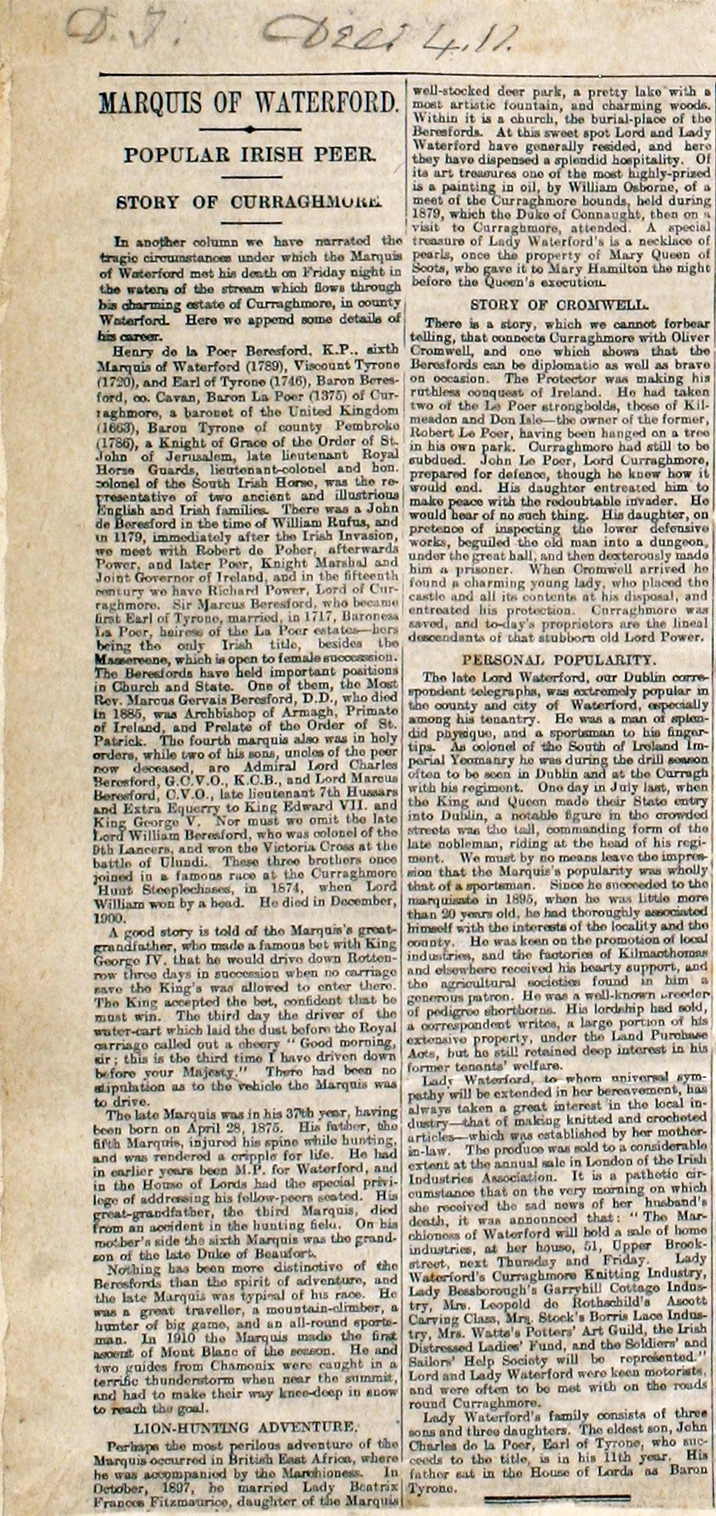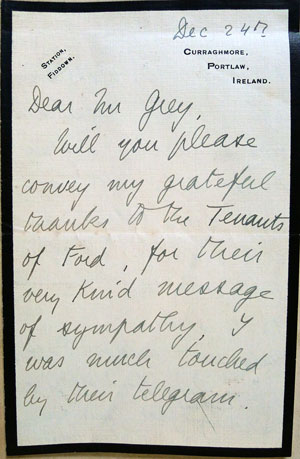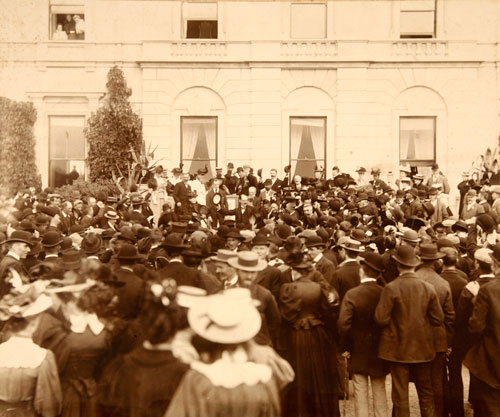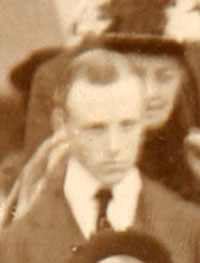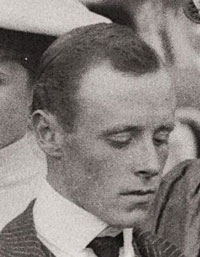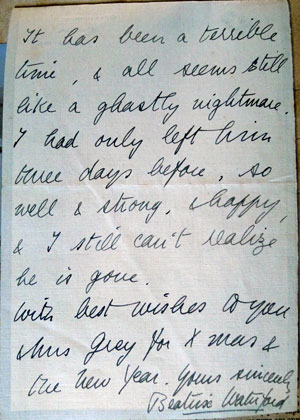Waterfords at the The Ford Estate.
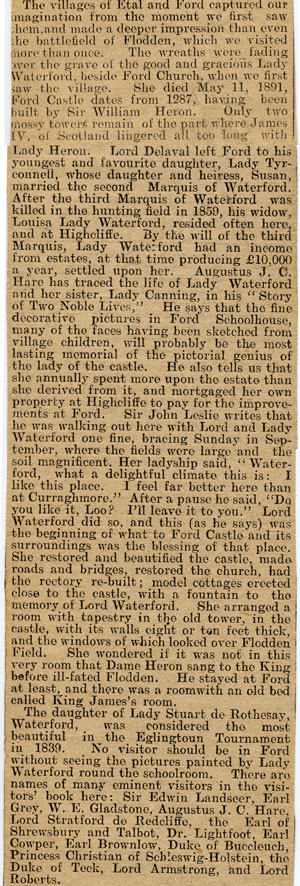


TRAGIC DEATH OF THE MARQUIS OF WATERFORD. ACCIDENTAL DROWNING. With much regret we have to record the death, under tragic circumstances, of the Marquis of Waterford. For some time past he had been staying at his Irish seat at Curraghmore, and it is believed that it was a desire to have a look at his pack of hounds before returning to dinner that led to his being drowned in the river which flows through the demesne. The Curraghmore pack is one of the finest in Ireland, and the Marquis took an extraordinarily interest in keeping it at its best. Only a few weeks ago he was amongst the exhibitors at the Clonmel Hunt Puppy Show, one of the three shows of the kind held in the country, and his puppies carried off every prize except one. On Friday he enjoyed a capital day’s hunting in the Curraghmore district, and returned home in excellent health and spirits. Towards evening he went for a walk to a part of the estate where some forestry experiments are being carried out. This was two miles distance from Curraghmore House. It was then four o'clock. Darkness fell soon afterwards, and there was a heavy fog during the earlier part of the night. It is believed that on his way home Lord Waterford visited the kennels. After leaving them he would have had to cross a small tributary of the Suir known as the Clodagh. Ordinarily it is but a shallow stream running through the estate, but after the recent rains it was much swollen. At the spot where the body was found on Saturday morning there were, it is stated, four feet of water. The bottom of the river at that point is filled with boulders. It is surmised that, while crossing, or about to cross, the Clodagh, Lord Waterford slipped and fell head foremost into the stream, his head striking the stones at the bottom and rendering him unconscious. When the dinner-hour passed and he had not returned, messengers from Curraghmore House were sent to look for him. Later others joined in the search, until a large number of the house staff and some of the tenantry were engaged in making a thorough search of the estate. Nothing, however, was discovered, although the search parties remained out all night. On Saturday morning a huntsman, crossing the little bridge near the kennels, saw the body on the stones at the bottom of the stream. Assistance was obtained, and it was taken out and carried to Curraghmore House, where medical examination showed that death had taken place several hours previously. On Saturday evening an enquiry into the circumstances of the death was held by the Deputy-Coroner for the County of Waterford, Mr J. Murphy, J. P. This served to throw some light on the manner in which the late Marquis came by his death. It was proved that it was dark when he reached the spot at which the body was found. A footmark on the steep riverbank showed that he had wandered slightly from the beaten track, that he must have fallen down the bank, and have been rendered unconscious. Lady Waterford, who was in London, at once prepared to start for Curraghmore on receipt of the news of her bereavement. Her ladyship left London shortly after seven o'clock in the evening. Sympathetic reference to the sad event was made yesterday in several churches in the district. The funeral will take place at Curraghmore on Wednesday. Full military honours will be accorded. A special memoir of the late Marquis will be found on page 9.
The Greys were estate managers for Ford. Ford was owned by the Delavals up to 1827 then by the Waterfords until 1907 and then the Joiceys. There are cuttings in the Milfield scrapbooks about each of these families. The third Marquis of Waterford (26 April 1811 – 29 March 1859) was killed in the hunting field and his widow Louisa Lady Waterford, developed Ford castle and village and painted the pictures in the
school room. The National Portrait Galley has 4 pictures of her.
1. 2. 3. 4. She was a friend of
Christian Grey, whose lady's maid features in one of the paintings.
Below: The death of the fifth Marquis, who shot himself. John Henry de la Poer Beresford, 5th Marquess of Waterford KP, PC (21 May 1844 – 23 October 1895).
Left and below: Death of 6th Marquis of Waterford who drowned. Henry de La Poer Beresford, 6th Marquess of Waterford, KP (28 April 1875 – 1 December 1911)
Left: A photograph of Curraghmore, found in the large Milfield Hill scrapbook. Marked on the mount as by Poole the Waterford photographer. It shows a welcoming party for two women. Possibly one is Louisa?
Enlargements of the photograph show that it was taken on the same occasion as a picture by Poole in
The National Library of Ireland which is labelled "Lady Waterford in carriage, Duke and Duchess of Waterford and other guests, Curraghmore House, Portlaw, Co. Waterford" and dated between 1900-1910.
Dec 24th CURRAGHMORE, PORTLAW, IRELAND STATION FIDDOWN Dear Mr Grey, Will you please convey my grateful thanks to the Tenants of Ford, for their very kind message of sympathy, I was much touched by their telegram. It has been a terrible time, & all seems still like a ghastly nightmare. I had only left him three days before, so well & strong, & happy, & I still cant realize he is gone. With best wishes to you & Mrs Grey for Xmas & the New Year. Yours sincerely Beatrix Waterford
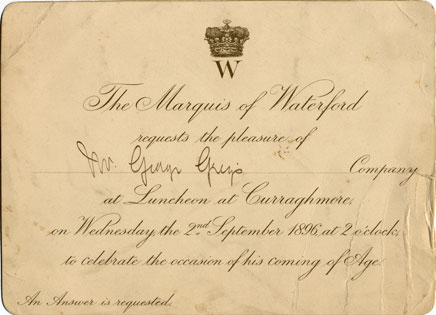
MARQUIS OF WATERFORD. POPULAR IRISH PEER. STORY OF CURRAGHMORE. In another column we have narrated the tragic circumstances under which the Marquis of Waterford met his death on Friday night in the waters of the stream which flows through his charming estate of Curraghmore, in County Waterford. Here we append some details of his career. Henry de la Poer Beresford, K.P., sixth Marquis of Waterford (1789), Viscount Tyrone (1720), and Earl of Tyrone (1746), Baron Beresford, co. Cavan, Baron La Poer (1375) of Curraghmore, a baronet of the United Kingdom (1663), Baron Tyrone of county Pembroke (1786), a Knight of Grace of the Order of St John of Jerusalem, late lieutenant Royal Horse Guards, lieutenant-colonel and hon. colonel of the South Irish Horse, was the representative of two ancient and illustrious English and Irish families. There was a John de Beresford in the time of William Rufus, and in 1179, immediately after the Irish Invasion, we meet with Robert de Poher, afterwards Power, and later Poer, Knight Marshal and Joint Governor of Ireland, and in the fifteenth century we have Richard Power, Lord of Curraghmore. Sir Marcus Beresford, who became first Earl of Tyrone, married in 1717, Baroness La Poer, heiress of the La Poer estates – hers being the only Irish title, besides the Massereene, which is open to female succession. The Beresfords have held important positions in Church and State. One of them, the Most Rev. Marcus Gervais Beresford, D.D., who died in 1885, was Archbishop of Armagh, Primate of Ireland, and Prelate of the Order of St. Patrick. The fourth marquis also was in holy orders, while two of his sons, uncles of the peer now deceased, are Admiral Lord Charles Beresford, G. C. V. O., K. C. B., and Lord Marcus Beresford, C. V. O., late lieutenant 7th Hussars and Extra Equerry to King Edward VII. and King George V. Nor must we omit the late Lord William Beresford, who was colonel of the 9th Lancers for, and won the Victoria Cross at the Battle of Ulundi. These three brothers once joined in a famous race at the Curraghmore Hunt Steeplechases, in 1874, when Lord William won by a head. He died in December, 1900. A good story is told of the Marquis’s great-grandfather, who made a famous bet with King George IV, that he would drive down Rotten-row three days in succession when no carriage save the King’s was allowed to enter there. The King accepted the bet, confident that he must win. The third day the driver of the water-cart which laid the dust before the Royal carriage called out a cheery "Good morning, sir; this is the third time I have driven down before your Majesty." There had been no stipulation as to the vehicle the Marquis was to drive. The late Marquis was in his 37th year, having been born on April 28, 1875. His father, the fifth Marquis, injured his spine while hunting, and was rendered a cripple for life. He had in earlier years been M. P. for Waterford, and in the House of Lords had the special privilege of addressing his fellow-peers seated. His great-grandfather, the third Marquis, died from an accident in the hunting field. On his mother's side the sixth Marquis was the grandson of the late Duke of Beaufort. Nothing has been more distinctive of the Beresfords than the spirit of adventure, and the late Marquis was typical of his race. He was a great traveller, a mountain-climber, a hunter of big game, and an all-round sportsman. In 1910 the Marquis made the first ascent of Mont Blanc of the season. He and two guides from Chamonix were caught in a terrific thunderstorm when near the summit, and had to make their way knee-deep in snow to reach the goal. LION-HUNTING ADVENTURE Perhaps the most perilous adventure of the Marquis occurred in British East Africa, where he was accompanied by the Marchioness. In October, 1897, he married Lady Beatrix Frances Fitzmaurice, daughter of the Marquis of Landsdowne, and it was shortly afterwards, while trekking in the big game country, that they were surprised by a lion, which bounded out of a thicket and knocked the Marquis down. The huge animal landed on the Marquis’s shoulder, and severely injured him. Two of the gun-bearers came to his lordship’s assistance, and the lion, with a spring, knocked one of them over and hurt the other. Lady Waterford was a spectator of this scene, only a few yards away. She stood bravely with a gun at her shoulder ready to fire, but afraid to do so lest she should hit her husband or one of the bearers. Happily the beast’s attention had been drawn to the two men; the Marquis reached his gun, fired straight into the lion’s eye, and killed it instantly. Even Livingstone’s escape at Mabotsa was hardly more wonderful. That lion’s skin is one of the most famous trophies at Curraghmore. HUNTING CAREER A shadow which will not easily be removed has been cast over Irish hunting circles by the death of one of the foremost Masters of Foxhounds on that side of the St George's Channel. The Marquis inherited all the love of fox-hunting which has been so characteristic of the Beresford family, and when in 1906 he agreed to take the Mastership of the Waterford Hounds, Irish sportsmen were delighted, recalling the glories of the old Curraghmore Hunt, established by the third Marquis about sixty years previously. The present Waterford Hunt differs from the original Curraghmore Hunt in that the hounds belong to the country, and are a subscription pack. But this did not deter the Marquis from endeavouring to breed a pack as brilliant as any which had previously hunted Waterford, and it can safely be said that no hounds have so greatly improved in recent years as those now kennelled at Curraghmore, where the Master provided a new home for them soon after accepting the command of the pack. As an example of Lord Waterford’s efforts to improve the kennel, it may be mentioned that he gave 360 guineas for two couples of Mr Frank Bibby’s entered bitches at the sale of the North Shropshire Hounds, and he was also a purchaser at other important hounds sales in recent years. Good-looking as his hounds are, he kept none for looks only, and the sport he showed compare favourably with the best in the history of Waterford fox-hunting. Perhaps the season of 1907–8 was the best he enjoyed. One Fox at Curraghmore helped to make that season specially memorable. This fox got the best of the hounds so frequently after grand runs that he became famous throughout the country, and for a long time was familiarly known as the “old customer.” Although the late M. F. H. had an occasional day with an English pack, most of his hunting was done in the counties of Waterford, Tipperary and Kilkenny. He once said that the best run he ever saw was with the Tipperary Hounds in his 21st year. A fox out of Quintan’s Gorse on that occasion took hounds over a point of eight miles in forty minutes, and was killed in the open. Last season Lord Waterford handed in his resignation of the Mastership, the fact that one or two foxes had been found poisoned in some parts of his country having caused him considerable annoyance. But he was induced to withdraw his resignation on the unanimous appeal of all classes, one petition from the Waterford Rural District Council beseeching him to go on with the hounds and “continue to ornament the position which he so brilliantly occupies" It has been said of his father, the fifth Marquis, that by his talent for organisation and his business-like aptitude for detail, he bought into trim an enormous country and the greatest hunting establishment Ireland has ever seen was in perfect order by the third year of his mastership. His men were beautifully mounted, and he always rode grand weight-carriers himself. The action of the Land League caused him to give up all this in 1881, and Lord Waterford, shutting down his entire hunting establishment, came to England for his winter’s sport. It has been estimated that the abandonment of the Curraghmore Hunt meant a loss of many thousands annually to the Waterford district. Much of the formal brilliancy of Curraghmore as a hunting centre had been revived by the sixth Marquis, in whom ran the sporting blood of the Beauforts as well as the Beresfords, and his sad death is a great blow not only to Waterford, but to Irish Hunting. Curraghmore, the stately home of the Beresfords, where all has been thrown into such deep sorrow by the lamented death of its owner, stands in the midst of one of the most beautiful estates in Ireland. The stretches of pasture land all round are delightful. The demesne comprises over 2,600 acres, which include a well-stocked deer park, a pretty lake with a most artistic fountain, and charming woods. Within it is a church, the burial-place of the Beresfords. At this sweet spot Lord and Lady Waterford have generally resided, and here they have dispensed a splendid hospitality. Of its art treasures one of the most highly-prized is a painting in oil, by William Osborne, of a meet of the Curraghmore hounds, held during 1879, which the Duke of Connaught, then on a visit to Curraghmore, attended. A special treasure of Lady Waterford’s is a necklace of pearls, once the property of Mary Queen of Scots, who gave it to Mary Hamilton the night before the Queen’s execution. STORY OF CROMWELL There is a story, which we cannot forbear telling, that connects Curraghmore with Oliver Cromwell, and one which shows that the Beresfords can be diplomatic as well as brave on occasion. The Protector was making his ruthless conquest of Ireland. He had taken two of the Le Poer strongholds, those of Kilmeadon and Don Isle – the owner of the former, Robert Le Poer, having been hanged on a tree in his own park. Curraghmore had still to be subdued. John Le Poer, Lord Curraghmore, prepared for defence, though he knew how it would end. His daughter entreated him to make peace with the redoubtable invader. He would hear of no such thing. His daughter, on pretence of inspecting the lower defensive works, beguiled the old man into a dungeon, under the great hall, and then dexterously made him a prisoner. When Cromwell arrived he found a charming young lady, who placed the castle and all its contents at his disposal, and entreated his protection. Curraghmore was saved, and to-day's proprietors are the lineal descendants of that stubborn old Lord Power. PERSONAL POPULARITY. The late Lord Waterford, our Dublin correspondence telegraphs, was extremely popular in the county and city of Waterford, especially among his tenantry. He was a man of splendid physique, and a sportsman to his fingertips. As colonel of the South of Ireland Imperial Yeomanry he was during the drill season often to be seen in Dublin and at the Curragh with his regiment. One day in July last, when the King and Queen made their state entry into Dublin, a notable figure in the crowded streets was the tall, commanding form of the late nobleman, riding at the head of his regiment. We must by no means leave the impression that the Marquis’s popularity was wholly that of a sportsman. Since he succeeded to the marquisate in 1895, when he was little more than 20 years old, he had thoroughly associated himself with the interests of the locality and the county. He was keen on the promotion of local industries, and the factories of Kilmacthomas and elsewhere received his hearty support, and the agricultural societies found in him a generous patron. He was a well-known breeder of pedigree shorthorns. His Lordship had sold, a correspondent writes, a large portion of his extensive property, under the Land Purchase Acts, but he still retained deep interest in his former tenants’ welfare. Lady Waterford, to whom universal sympathy will be extended in her bereavement, has always taken a great interest in the local industry – that of making knitted and crocheted articles – which was established by her mother-in-law. The produce was sold to a considerable extent at the annual sale in London of the Irish Industries Association. It is a pathetic circumstance that on the very morning on which she received the sad news of her husband's death, it was announced that: "The Marchioness of Waterford will hold a sale of home industries, at her house, 51, Upper Brook Street, next Thursday and Friday. Lady Waterford's Curraghmore Knitting Industry, Lady Bessborough’s Garryhill Cottage Industry, Mrs. Leopold de Rothschild’s Ascott Carving Class, Mrs. Stock’s Boriss Lace Industry, Mrs Watt's Potters’ Art Guild, The Irish Distressed Ladies’ Fund, and the Soldiers’ and Sailors’ Help Society will be represented." Lord and Lady Waterford were keen motorists, and were often to be met with on the roads round Curraghmore. Lady Waterford's family consists of three sons and three daughters. The oldest son, John Charles de la Poer, Earl of Tyrone, who succeeds to the title, is in his 11th year. His father sat in the House of Lords as Baron Tyrone.
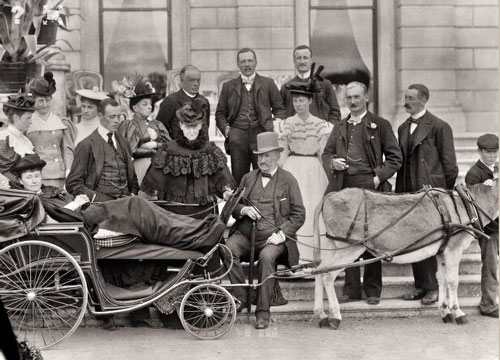

Ford was later owned by the Joicey family.
"Father came home from Ireland on Thursday afternoon. It is a very tiring journey as the nights were broken in on by having to change trains and wait at stations. He was only one night and two half days at Curraghmore but he enjoyed it very much. He says it is a splendid place – a park of 3000 acres full of deer – a big river in it and a ride three miles long that you can look right along and planted with rhododendrons on both sides. The stables are joined on to the house like this.[sketch] L'd and Lady Waterford were very nice and kind and anxious for father to stay and hunt but he had to be home for the let."
From an undated letter from Christian Grey to her son Ivar in Germany. Possibly 2 Sept 1896, see below right.

